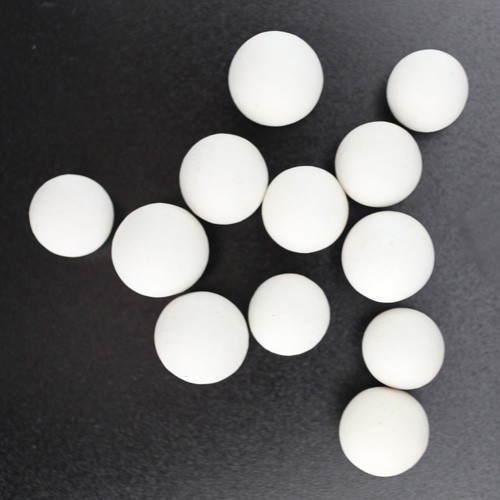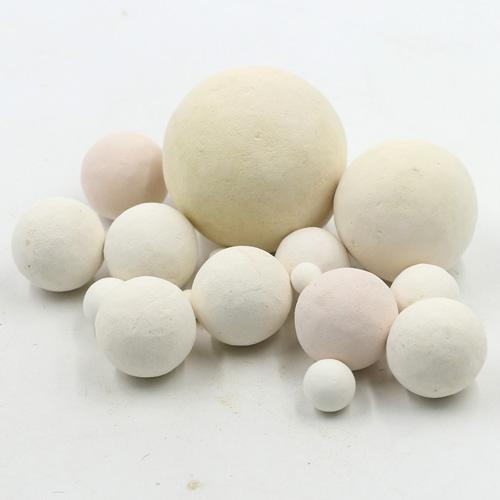
Polishing high alumina ceramic ball for ball mill
The microcrystalline wear-resistant alumina ball is a high-quality grinding medium made of selected high grade material, advanced molding technology and calcined in high temperature tunnel kiln. Possessed with high density, high hardness, low wear, good seismic stability and good corrosion resistance, the products are the most ideal medium for grinding glaze, blank and mineral powder processing, and are used as the grinding medium of ball mill in ceramics, cement, paint, refractory, inorganic mineral powder and other industries.
We can produce products according to customers' specification.
|
Items |
Content |
Others |
Hardness |
Bulk Density |
Self Wear Rate |
Water Absorption |
|
92% Alumina Balls |
≥ 92% |
<8% |
≥9 |
>3.63 |
<0.01% |
<0.01% |
|
80% Alumina Balls |
≥ 80% |
<20% |
≥8 |
>3.30 |
<0.02% |
<0.02% |
|
68% Alumina Balls |
≥ 68% |
<32% |
≥7 |
>3.00 |
<0.03% |
<0.02% |
Normal size:1mm, 2mm, 3mm, 4mm, 5mm, 6mm, 7mm, 8mm, 9mm, 10mm, 11mm, 12mm, 13mm, 14mm, 15mm, 16mm, 17mm, 18mm, 19mm, 20mm, 25mm, 30mm, 40mm, 50mm, 60mm. 70mm, 80mm, 90mm, 100mm These sizes our factory produce regular, many of them are in large stock.
Normal size: 20mm, 25mm, 30mm, 40mm, 50mm, 60mm. 70mm These sizes our factory produce regularly, many of them are in large stock.other sizes beyond this range, also could produce for you, please contact us to get more infos.
Normal size: 30mm,40mm,50mm,60mm. These four sizes have very large stock.
Application:
In a certain operating and regeneration conditions,Active alumina ball desiccant has drying depth of up to -40 degrees below the dew point, is a trace of water depth of the desiccant efficient, single molecule adsorption layer of net heat, So very suitable for non-thermal regeneration device.
① Active alumina ball desiccant can be used as a defluorination agent of high fluoride drinking water (fluoride removal capacity), alkyl benzene production cycle of defluorination agent, transformer oil deacidification regeneration agent;
② Activated alumina ball desiccant can be used as oxygen desiccant for the oxygen industry, textile industry, automatic instrument, chemical fertilizer and petrochemical industry, and the dew point of PSA in the air separation industry can reach -55 degrees;
③ High-performance activated alumina ball in the unshaped refractory ingredients can bring the following benefits: to improve the density of the body, fluidity, strength, increase the amount of secondary mullite, reduce the water and porosity;
④ In addition as a desiccant, the active alumina ball can also be contaminated with oxygen, hydrogen, carbon dioxide, natural gas and other lubricants in the adsorption of steam;
⑤ Active alumina ball can be used as a catalyst, catalyst carrier, chromatography analysis of the carrier.
Packing
① Packing: 25kg / bag (lined with plastic bags, the outer layer of plastic laminated bags). This product is non-toxic, to be waterproof, moisture-proof, non-oil and oil contact with steam.
② Transport: Do not drag with iron hook, prevent to be mixed with hard materials, not strong vibration, friction, step on, smashing, throwing is prohibited, should be light loading and unloading to reduce the packaging broken.
③ Storage: Store in a cool and dry place, to prevent the rupture of inner and outer bags, to prevent moisture and other substances affect the use of results, storage away from sources of pollution; Do not open the package before use, so as not to absorb moisture and affect the use of results.
④ Applicable conditions: activated alumina ball desiccant is for deep drying, pressure> 5kg/cm2 is appropriate.
⑤ Regeneration: activated alumina ball on gas, water vapor and some liquid moisture has selective adsorption capacity. Adsorption saturation can be heated at about 175-315°C to remove water and resurrection, adsorption and resurrection can be carried out several times.

Brown Fused Alumia powders are fused wIth premium raw materials and 3500 KVA furnace. It is perfect material specifically manufactured to be used for general abrasive applications in bonded abrasive tools, polishing and sandblasting grit. It has lower hardness and abrasive capacity than diamond, boron carbide, and silicon carbide, it is widely used for grinding ferrous materials, finishing tough and hard materials. It is also be used as high-class refractory materials. Brown Fused Alumia is offered in macro and micro powder form, in both F and P grades.
Magnesia alumina bricks use periclase as the main crystal phase and magnesia-alumina spinel as the matrix. They are better in thermal shock resistance than magnesia bricks. In order to improve the thermal shock resistance of magnesia bricks, alumina or alumina is introduced into the ingredients. Bauxite clinker fine powder to form a magnesia-alumina sharp stone matrix, thereby making magnesia-alumina bricks
Chrome corundum brick refers to corundum refractory products containing Cr2O3. At high temperature, Cr2O3 and Al2O3 form a continuous solid solution, so the high temperature performance of chromium corundum products is better than that of pure corundum products. Chromium corundum products are widely used, and the content of Cr2O3 is mostly in the range of 9% to 15%.
Silicon carbide castables mainly use 98 silicon carbide as the main raw material, add water reducing agent and micropowder, and use pure calcium aluminate cement as binder to make amorphous refractory materials. Cupola and other high temperature materials to be recorded.
Special Acid-proof Brick Lightweight acid-proof Brick Acid resistant brick is the ideal choose for your project with their features of proof pressure, corrosion resistance, easy to clean and acid-base resistance.
The heavy part of the raw materials for the chrome zirconium corundum composite brick is sintered tabular corundum, high-purity chromium oxide, high-purity zircon, and Guangxi white cement.As the main raw material, the light part of the raw material is made of 47 mullite, kyanite, floating beads and coke gemstones as the main raw materials. During molding, a separator is set in the middle of the mold, and heavy materials and light materials are added at both ends. After high pressure molding , finished products made of high temperature sintering.
High alumina refractory bricks are the backbone of high-temperature industrial processes. By understanding their properties, applications, and supplier selection criteria, businesses can enhance operational efficiency and reduce downtime. For industries seeking durable, cost-effective solutions, partnering with certified refractory materials suppliers in China ensures access to cutting-edge technology and reliable supply chains.
The refractoriness of clay bricks is comparable to that of silica bricks, up to 1690~1730℃, but the softening temperature under load is more than 200℃ lower than that of silica bricks. Because in addition to the high refractory mullite crystal, the clay brick also contains nearly half of the low melting point amorphous glass phase.



